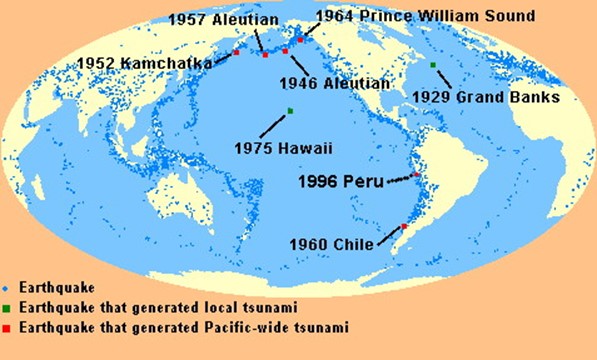EARTHQUAKE
These are sudden earth movements or vibration in the earth’s crust; they are caused by.
i. When one tectonic plate sliding over/or past another plate along the line of a faulty
ii. Volcanic eruption- The movement of molten rock below or onto the earth’s crust which in turn is caused by the movement of plates.
Nature of Earthquakes
•The point of which on earthquake is originate is called focus. And sometimes it is several kilometres below the surface.
•The point on the earth’s surface immediately above the focus is called the Epicentre, This is where the shock waves first hit the surface. It is the shock waves which gives rise to an earthquake.
Types of shock waves
There are two types of shock waves:-
1.Body waves.
Are waves which travel through the erust and are of two types
i. Primary waves- which cause the crustal rock to move back and forth in the direction of wave movement
ii. Secondary waves- Are waves which cause the crustal rock to move side to side ie right angles to the direction of wave movement.
2.Surface wave.
These travel through the surface and are of two types
i.Love wave;- Which cause the surface rock to move side to side of right angles to the direction of wave movement.
ii. Rayleigh wave;- Wave which cause the surface waves to have a circular movement very similar to that of water wave movement.
I/
II/ 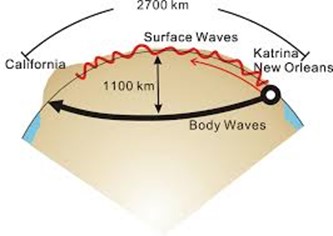
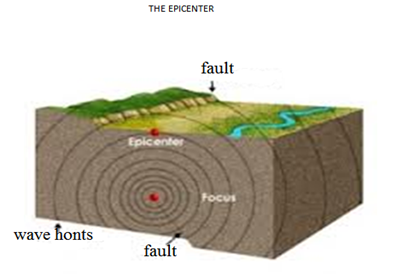
DETECTING MAGNITUDE AND INTENSITY
The intensity of an earthquake is measured by an instrument called seismograph, This is the instrument which record the vibration produced by an earthquake.
The magnitude of an earthquake -refer to the total amount of energy released and the scale which gives the magnitude is called the Richter scale, The scale range from 0 to 8.9
Effects of Earthquake
•Rise and fall of the sea floor Eg. Agadir Earthquake in Morocco in 1960
- Displacement of the earth’s crust, it can happen vertically or laterally.
- Land slides and open up deep cracks in the surface rocks eg. The El Asnam earthquake in Algeria 1954 destroyed an area of radius 40km and open surface cracks up to 3m deep.
- Destruction of infrastructure and properties
- Loss of life, can lead to death’s
- They can raise or lower erosion rocks eg. In Alaskan the earthquake of 189 lead to raise of some rock for about 16km.
edu.uptymez.com
2. VOLCANIC ERRUPTIONS/VULCANICITY/VULCANISM
The map above is a part of a recently released world map that shows, in blue, the presence of the underground water
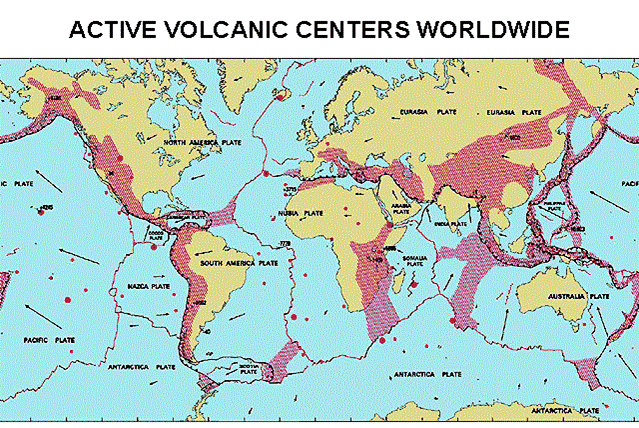
The map above is a part of a world map that shows, in red, the presence of Active volcano centers
VULCANICITY
Vulcanicity is the range of processes by which molten materials and gases are either intruded (injected) or extruded (ejected) into the earth’s crust or into the earth’s crust respective
- Vulcanicity is the formation of various feature due to the intrusion or extrusion of molten materials, and gases.
- The molten materials are called magma when found within the earth’s crust and magma when poured on the earth’s crust.
edu.uptymez.com
Vulcanism/Vulcanicity – Is a broader term which includes both extensive and intrusive igneous activities while volcanicity – Refers to the extensive volucancity in which the materials are forced at onto the surface.
Origin of magma
Origin of magma is within the earth’s crust where it kept as a molten rock due the influence of temperature.
Magma can be ejected out through fissures or vent.
- Magma when passed through vent result the formation of volcanic features like volcanic cones.
- Magma when passed through fissures leads to the formation of lava plateau.
edu.uptymez.com
Types of vulcanicity
There are two types of vulcanicity which are classified as follows
1. INTRUSIVE VOLCANIC FEATURES
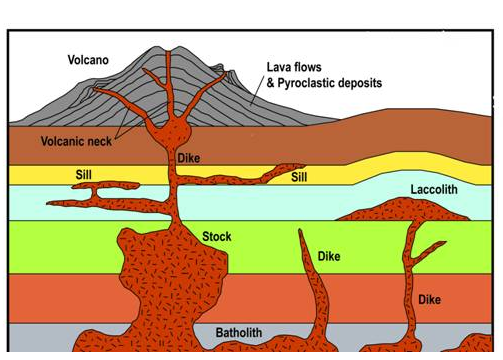
This is when magma intruded within the earth’s interior. The features resulted due to the intrusive volcanic erruption is called intrusive features.
The intrusive volcanic features are the features which are found within the earth’s interior. The following are intrusive volcanic features.
- Sill – is a rock sheet formed when the magma solidifies horizontally along the bedding plane. Eg:- Tyolo scarp in Malawi
edu.uptymez.com
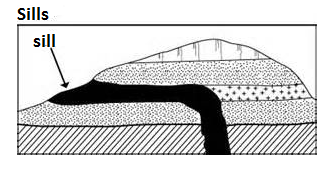
- Dyke- is a rock sheet formed when the magima solifies vertically across the bedding planes. Eg:- Kinkon
edu.uptymez.com
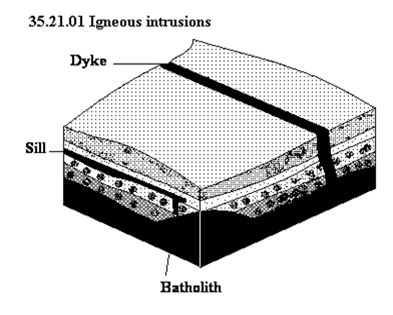
Laccolith is the cone dome shaped mass of rock with flat formed of viscus lava. It look like a mushroom. Eg:- Laccolith found in Morafonobe in Madagases.
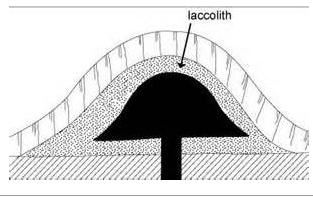
- Lapolith –is a scar shaped mass of rock formed in glosyncline. It forms a saucer – like shape may be due to the increased weight of the deposits
edu.uptymez.com
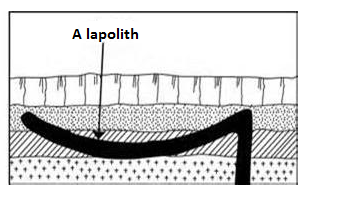
- Phacolith – is a leans shaped strip of igneens rock formed when the magima solidies along the anticline or syncline. Eg: Cordon wills in U.K Phacolith
edu.uptymez.com
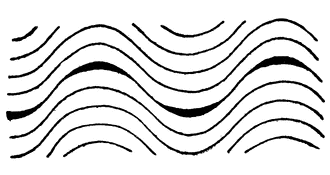
- Batholith is the large mass of solidified rock formed when magma cools plutonically at the great dept Eg: at the heart of the mountain ranges. Eg:- Chilu Batholic in Gabon
edu.uptymez.com
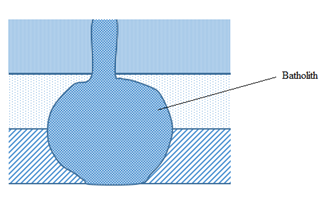
2.Extrusive volcanic features
Are the features formed when the magma cools and solidifies on the earth’s surface.
The extrusive volcanic features can be classified into the following
I. Central features
II. Fissure features
- The central features due to the violent eruption include
edu.uptymez.com
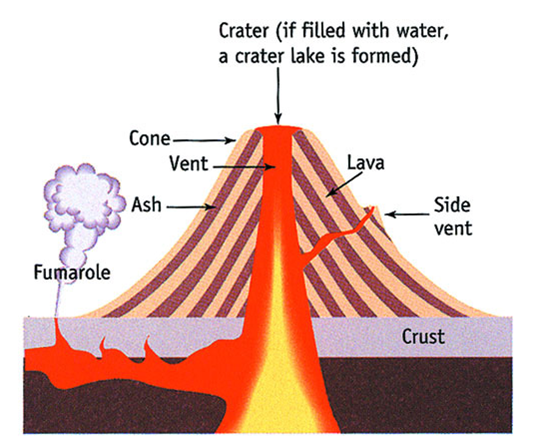
- Ash and cinder cone. Lava is blown to great heights when it is violently ejected and it breaks into small fragments which fall back to earth and build up a cone, example Busoka and Bitale in South west Uganda.
edu.uptymez.com
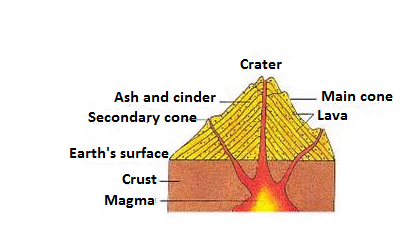
• Composite cone
This type of cone is formed of alternate layers of lava and ash. The volcano begins each eruptions with great violence forming a layer of ash. As the Eruption proceeds the violence ceases and lava pours out forming a layer on top of the ash, Lava often escapes from the sides of the cone where it builds up small conelets.Example mount Kilimanjaro in Tanzania and mount Cameroon
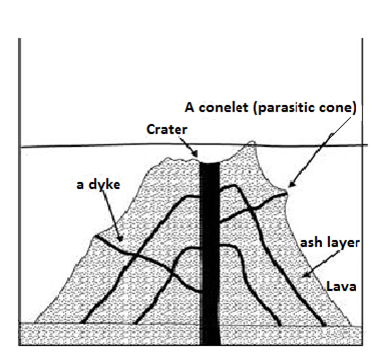
• Volcanic plug/plug dome volcano. Is a rigid cylindrical plug formed when very viscous lava is forced out of the volcano and form a plug dome that may completely block the vent. Good examples of a plug dome occurs in the Atakor volcanic area of Haggar mountains in Algeria. These are almost 300 plug domes in these region
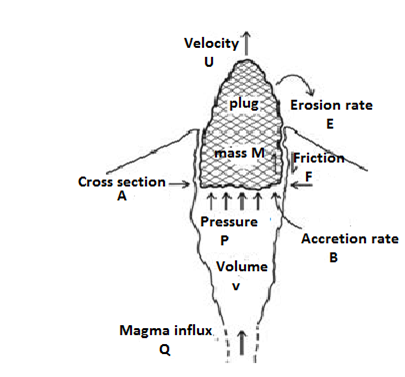
• Crater is a depression formed on the summit of the cone after the plug dome has been blown off on the top of the cone.
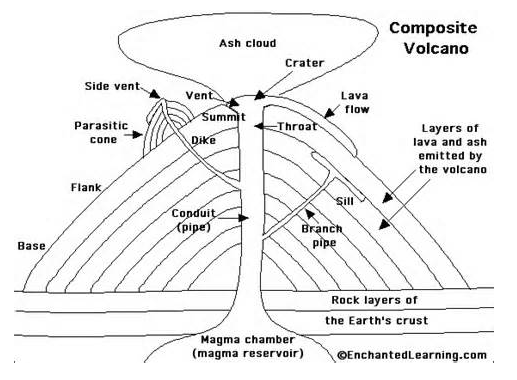
• Caldera is a large crater formed when the upper part of the volcano is either bombarded away by a violent eruptions or subsides into the crust. Eg:- Alaska, Ngorongoro in Tanzania, Eboga in Cameroon
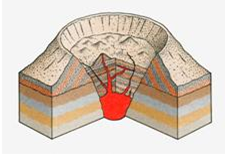
Central features due to peacefull eruptions
The lava coming onto through the vent can be acidic and hence viscous or basic and hence less viscous.
The following are the central features due to peacefull eruptions
• Acid lava cone/comulo dome volcano- is the dome shaped volcano with convex slopes formed when acidic lava solidifies around the vent Eg:- Ntumbi dome (Mbeya)
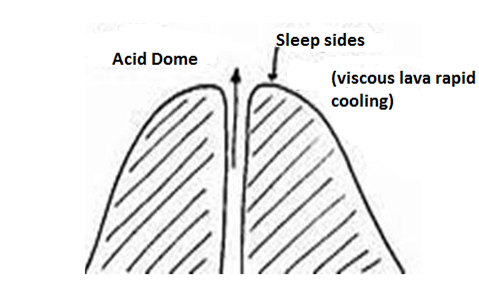
•Shield volcano:- is an extensive cone with gentle sloping sides formed when basic (basalt) is poured on the surface and spread to occupy large area.
Sometime times these features can be formed when lava comes out through a single fissure or many fissures.
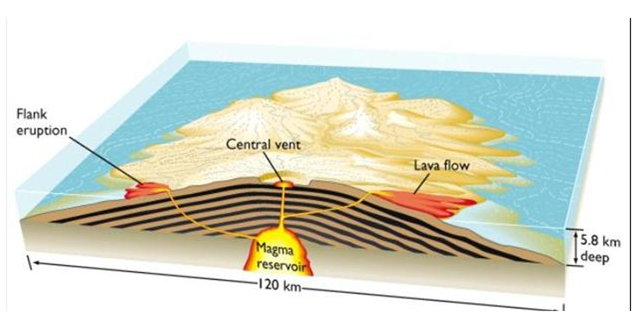
• Fissure eruption
The fissure eruption involve lava coming out through a crack or fault. The feature formed is called lava plateau.
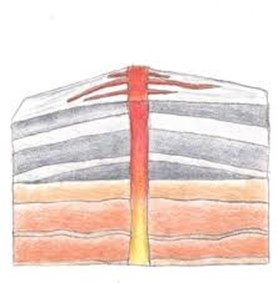
Minor volcanic features
A variety of minor volcanic forms can be distinguished, usually though not necessarily associated with volcanoes approading extinction. They include the following
•Mofettle – is the volcano which emit carbondioxide gas.
•Hot spring – is the volcano which emits hot water.
•With dissolved minerals suspension.Salfatara – is the volcano which emits sulphur gas.
•Fumerole – is the volcan which emits steam, mud and other gas than sulphur.
OR:-
Is the outflow of superleated water from the ground which contains some mineral substances in solution or in suspension
Hot springs mostly occur in island or in some of the African countries such as Kenya and Ethiopia.
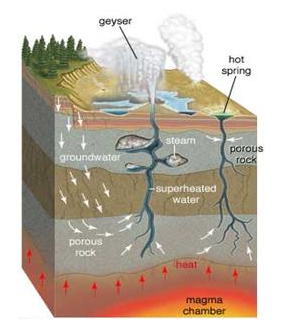
1.Geysers – are the forceful omission of hot water from the ground to high level in the atmosphere when emitted contains fine material forms mud volcano which later can lead to the formation of very fertile soild
- Types of volcanoes according to the activity
edu.uptymez.com
There are three types of volcanoes according to the activities. These include:-
I. Active volcano: is the volcano which erupts frequently. Eg:- Oldonyo Lengai in Tanzania and Mount Cameroon.
II. Dormant volcano is the one which has stopped erupting but not extinct and it is expecte to erupt.
The dormant volcano is also known as sleep volcano.
III. Extinct volcano. Is the volcano which has stopped erupting for a very lon time in history and is not expected to erupt.
It is also known as dead volcano.
INFLUENCES OF VOLCANIC ERUPTION TO MAN AND ENVIRONMENT
The following include the economic importance of volcanic eruptions to man.
i. Lava on weathering head to the formation of very fertile soil which support agriculture.
ii. Volcanicity eruption lead to the formation of mineral deposits like copper deposits of butte in USA, diamond of kimberley in South Africa.
iii. Volcanic eruption provide geothermal power for electric generation
iv. Some hot hot springs utilized for heating homes in glaciated region
v. Volcanic features attract tourist
vi. Volcanic cones are the source of rivers.
DISTRIBUTION OF VOLCANIC ACTIVITIES IN THE WORLD
Distribution of volcanic activities corresponds to the earthquake belts. They are common along the zones of convergence like in the circum pacific ring and Alpine – Himalayan belt, zones of divergence like Atlantic ridge belt and along the fealty belts like the African rift valley.
EARTHQUAKE
These are sudden movements or vibration in the earth’s crust caused by
i) One tectonic plate sliding over another along a line of a features
ii) Volcanic eruption – The movement of molten rocks below or on to the earth’s crust.
iii) Mass movements like landslides and rock falls. Can causes earthquake but in local scale.
iv) Falling of large objects from the atmosphere such as meteorites lead to the shaking of the earth’s crust.
v) Man’s activities or influence, such as quarrying rocks using explosive like dynamite, transept vellsel’s e.g trains and heavy trucks
THE NATURE OF EARTHQUAKE
FOCUS: Is the point at which an earthquake originates and sometimes it is several kilometer below the surface
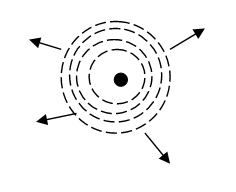
EPICENTRE: Is the point as the earth’s surface immediately above the focus. This is where the shock waves first lit the surface. It is the shock waves which give rise to an earthquake.
There are two types of shock waves.
i) Body waves
ii) Surface waves
i) Body waves – this travel through the crust and is of two types.
a) Primary waves – Which cause the crustal rock to more back and forth in the direction of wave movement.
b) Secondary waves – Which cause the crustal rock to more from side to side that is at right angles to the direction of waves movement.
ii) Surface waves – These travel through the surface rocks and of two types
a) Love (L) waves which cause the surface rocks to more from side to side , at right angles to the direction of wave movements
b) Rayleigh (R) waves which cause the surface rocks to have a vertical circular movement very similar to that of water in a sea were. The vibrations caused by the surface wave produce most of the damage that occurs in an earthquake. The violent shaking of the surface rocks often cause great damage to buildings and sometimes considerable loss of life.
HOW TO DETECT AN EARTHQUAKE
The intensity of an earthquake is measured by an instrument called a seismograph. This instrument records the vibrations produced by an earthquake. The magnitude of an earthquake refers to the total amount of energy released and the scale which gives the magnitude s called the Richter scale. This scale ranges from O to 8.9. A magnitude of 2.0 is ten times greater than that of 1.0 and one of 5.0 is 10,000 times greater than one of magnitude 1.0.
The intensity of an earthquake – refers to the effect produced by the earthquake of course these varies from place to place so while the intensity of a specific earthquake varies its magnitude does not vary. It is important not to confuse magnitude with intensity.
EFFECTS OF EARTHQUAKES
1) Development of rift valley or basins
2) Landslides can occur and these in turn can lead to land degradation
3) Collapse of houses and other structures as well as loss of life. E.g in 1906 the earthquake killed a number of 700 people in San – Transits
4) Fire outbreak in cities, San – Transits damage due to fire outbreak.
5) Tsunamis (waves in the ocean due to earthquake)
POSSIBLE AREAS WHERE EARTHQUAKE IS LIKELY TO OCCUR ON WORLD MAP.
